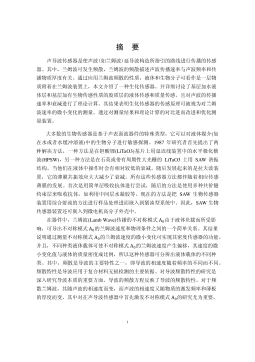表面肌电信号对医疗器械人因设计评价的研究
I摘要医生在操作医疗器械时,往往由于一些医疗器械不符合医疗仪器的人因工程学设计的要求而使一些医生患上与职业相关的骨骼肌肉疾病(Work-relatedMusculoskeletalDisorders,WMSD)。如何防止各种类型的与职业相关的骨骼肌肉疾病是工效学/人因工程学的重要研究内容。表面肌电(surfaceelectromyography,sEMG)技术作为一种生理指标测量技术,可用来对神经肌肉功能状态和活动水平做出评价,从而可用来对医疗器械人因工程学设计进行评价。本文设计并开发了一种表面肌电信号采集分析系统。根据肌电信号的特点和研究要求,本系统采用研华公司生产的PCI-1710HG数据...
相关推荐
-
10KV电网D-SCADA 系统信息采集与故障诊断研究与设计VIP免费

 2024-10-14 38
2024-10-14 38 -
方形吸顶散流器平送风等温射流特性研究VIP免费

 2025-01-09 11
2025-01-09 11 -
关于充液声导波传感器中频散兰姆波的研究VIP免费

 2025-01-09 15
2025-01-09 15 -
结合梁斜拉桥施工过程中考虑剪力滞影响的分析方法VIP免费

 2025-01-09 23
2025-01-09 23 -
空调房间热舒适性的数值模拟与实验研究VIP免费

 2025-01-09 8
2025-01-09 8 -
汽车前轮线控转向系统研究VIP免费

 2025-01-09 11
2025-01-09 11 -
输入分配型混合动力车辆动力系统控制策略研究VIP免费

 2025-01-09 8
2025-01-09 8 -
双馈风力发电系统的柔性并网控制研VIP免费

 2025-01-09 21
2025-01-09 21 -
污水处理厂污泥好氧堆肥发酵技术的试验研究VIP免费

 2025-01-09 10
2025-01-09 10 -
应用风室试验装置的风机性能VIP免费

 2025-01-09 12
2025-01-09 12
相关内容
-

汽车前轮线控转向系统研究
分类:高等教育资料
时间:2025-01-09
标签:无
格式:PDF
价格:15 积分
-

输入分配型混合动力车辆动力系统控制策略研究
分类:高等教育资料
时间:2025-01-09
标签:无
格式:PDF
价格:15 积分
-

双馈风力发电系统的柔性并网控制研
分类:高等教育资料
时间:2025-01-09
标签:无
格式:PDF
价格:15 积分
-

污水处理厂污泥好氧堆肥发酵技术的试验研究
分类:高等教育资料
时间:2025-01-09
标签:无
格式:PDF
价格:15 积分
-

应用风室试验装置的风机性能
分类:高等教育资料
时间:2025-01-09
标签:无
格式:PDF
价格:15 积分






